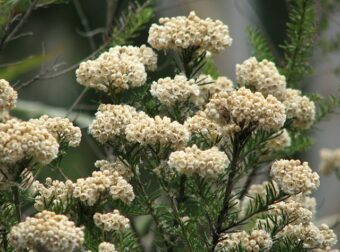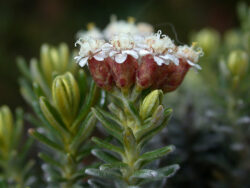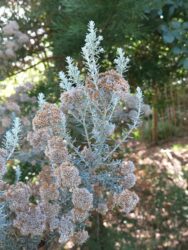In this article, we will discover how to grow the unusual shrub of Ozothamnus in containers. Ozothamnus is a genus of around 50 shrubs that were once classed as belonging to Helichrysum, but no more. Ozothamnus itself belong to the family Asteraceae (the Asters), which is a huge family of different genii of plants, including shrubs.

They are native to Australia, New Zealand and New Caledonia. Although 50 species exist, you will only find two species often sold here in the UK. These are Ozothamnus ledifolius and Ozothamnus rosmarinifolius. They share so many features that are common with Helichrysums such as narrow leaves, and small flowers surrounded by long-lasting bracts. The main difference that distinguishes between the two is that Ozothamnus have red or reddish flower buds, which open to form white flowers with brown or red bracts beneath.
As mentioned previously they are often upright, evergreen shrubs whose leaves are narrow, and silvery-grey. On top of these slightly rounded terminal clusters of pink buds appear that open revealing tiny white flowers that are richly scented. The flowers appear in early summer. The bracts can be anywhere from yellow to almost brown. This is common for Ozothamnus rosmarinifolius (Rosemary Ozothamnus) whose young stems are covered with fine, wool-like hairs.
The other species you are likely to find is Ozothamnus ledifolius (the Kerosene Bush) so called because the gasses released on the underside of the 12.5cm long green leaves and the stems readily catch on fire. This is a sight to behold but it only happens in hot countries and does not often happen in the UK.
Find out how to grow the unusual species of Ozothamnus in containers in this article.
GROWING OZOTHAMNUS IN CONTAINERS

As they can grow up to 1.5m tall then you will need a large container to grow them in. First, choose a container that is half-barrel in size and has plenty of drainage holes at the bottom. Fill this container with a 2cm layer of gravel to aid drainage more. On top of the gravel create a light and free-draining growing media by mixing 70% by volume of multipurpose compost with 305 by volume of perlite. Fill the container up to 5cm of the top rim with this mixture.
At the centre of the container dig a hole slightly bigger than the root ball it came in the original container you bought it in. Place the plant in this hole so that the top of the root ball is at the same level as the top surface of the compost. Backfill with the growing media so that no vacant spaces remain, using more compost if you deem it to be necessary. Firm the plant in and water the well to settle the growing media around the roots.
THE BEST GROWING CONDITIONS
This is one sun-worshipping plant and will not do well in the shade. Place your plant on a sheltered spot against a wall on a south-facing spot.
Watering is very important in the first year until the shrub is well established. So water the compost when it feels dry to the touch. After this, it can take drought pretty well as it can grow in coastal or Mediterranean climates. It is best to water when 5cm below the top surface of the compost feels dry to the touch.
Each spring you can give a feed of general-purpose slow-release fertilizer at the manufacturer’s recommended dosage. Pruning is not necessary making it an ideal container plant but it is recommended that if you do want to prune them you can do so and cut back to maintain a bushy growth habit.
Propagation is via semi-ripe cuttings taken in summer and planted in a pot full of seed and sowing compost, placed in a cold frame. It should be ready for planting outside the following year.
PESTS AND DISEASES
If you are looking for a plant that does not suffer from pests and diseases then this is the plant for you. They do have a reputation for being tender but the species I suggest in this article are hardy as long as you grow them in a sunny, sheltered, South-facing wall. If you do this your shrub will give many years of enjoyment.
VARIETIES TO GROW

The species to grow include the two I recommend in the introduction- Ozothamnus rosmarinifolius or Ozothamnus ledifolius. Both have been described in detail in the introduction. For Ozothamnus, the variety to grow is ‘Silver Jubilee’ which has silvery-grey leaves and produces red buds in dense terminal clusters before opening and revealing tiny, white flowers. The plant was named to commemorate the Queen’s 25 years on the throne.
CONCLUSIONS
In this article, we have discussed how to grow the beautiful Ozothamnus shrub in containers. They are not only beautiful to look at but are maintenance free and they do not suffer from pests and diseases. The flowers are not only pretty to look at but also scented as well. A plant that should be grown more in the garden, especially the container garden.
If you have any questions or comments that you wish to make on growing Ozothamnus in containers, please do so in the comment box below.
Happy Ozothamnus growing.
